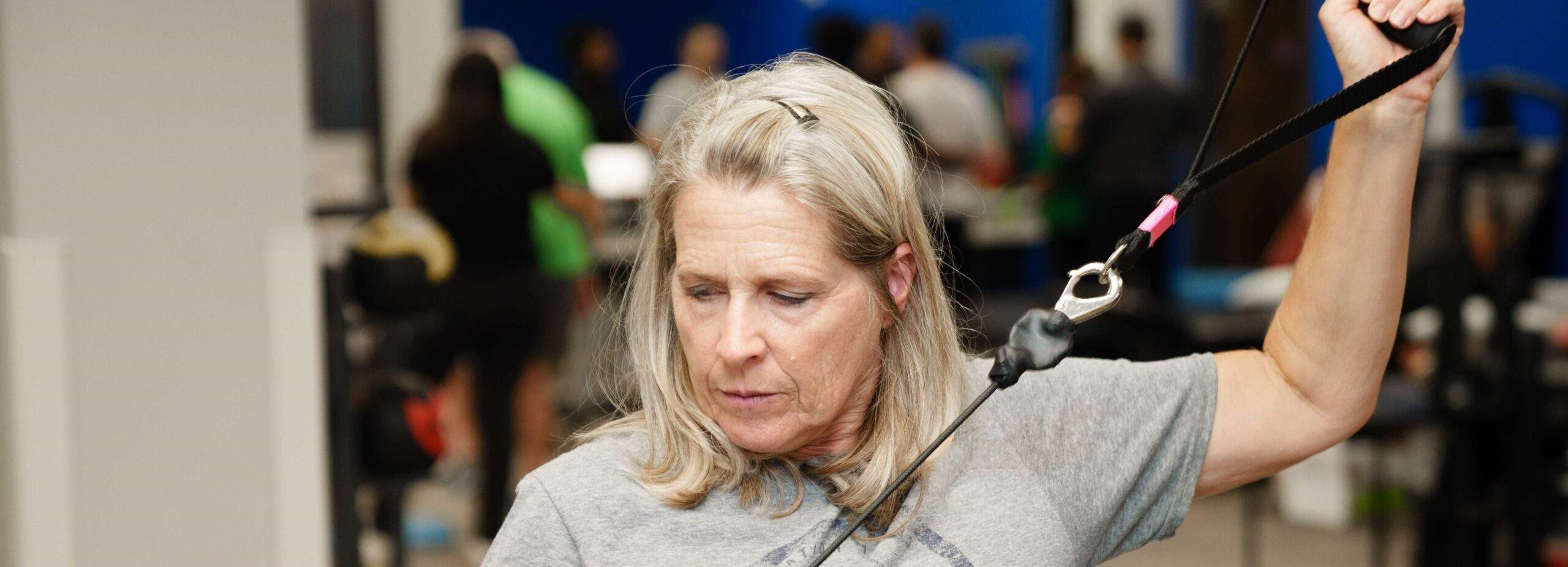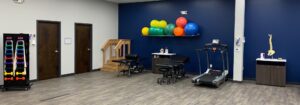Rounded Shoulders? There is More To It Than Just “Stand Up Straight.”

Back to physical health resource hub
Today, it seems we’re seeing more and more cases of “rounded shoulders.” Is it all about bad posture habits, like looking at our phones? Are certain muscles or joints tight or unattended to? Do social conventions play a part?
Posture is a complex construct that combines body structures, learned habits over time and even cultural influences to create a “holding pattern” for our bodies.
Rounded shoulders posture is more about the position of the shoulder blades on the rib cage versus a position of the spine. The shoulder blade or scapula is actually a semi-floating bone held onto your skeleton solely by various muscles and two small joints at either end of the collar bone. While this allows tremendous freedom and mobility of the arms, it also allows for wildly variable shoulder blade positioning at rest, resulting in many variations of a “normal” posture including “rounded shoulders.”
Thinking structurally, we can point to a few muscle groups that contribute to the rounded shoulders posture. First would be the pectorals. We often see tightness in the pectoralis major and minor muscles on the front of the chest that pull the shoulder blades forward on the rib cage. We also see a weakness in the serratus anterior, rhomboids, middle and lower trapezius muscles that should be able to counteract this forward pull of the pecs by anchoring the shoulder blades against the rib cage. When these muscles are weak, the pecs are able to pull the shoulders forward without much of a fight, causing rounded shoulders.
We also have habits that contribute to rounded shoulders posture. The majority of us who work on a computer most of the day are more apt to demonstrate this posture, largely because of the aforementioned muscle weakness, as well as the poor ergonomic set ups of most desks and office chairs. Phone and other handheld device use also contributes to the maintaining of rounded shoulders because looking down, also known as neck (cervical spine) flexion, causes the upper back (thoracic spine) to bend forward as well, further rounding the shoulders. We are also seeing a change in our environments that support us in these inefficient “holding patterns,” for example cars that have rounded sides of the seats that allow or even force us into a rounded shoulders posture. These environmental adaptations were not as prevalent 10 or more years ago.
There are also social or cultural influences that affect a rounded shoulders posture. For instance, females in adolescence who are developing breast tissue may be embarrassed, leading them to round the shoulders to try to hide their development. A child who is growing faster than his or her peers may resort to a rounded shoulders posture to try to fit in. Or we may subconsciously feel we will be perceived as arrogant if we stand up too tall or have our chest out, so we round the shoulders to improve others’ perceptions of us.
A forward head often accompanies rounded shoulders because the neck or cervical spine naturally follows the upper back or thoracic spine. When the upper back flexes forward, the neck follows, resulting in you looking down at the floor or at a device. So, in order to see the world around us, our bodies naturally compensate by tipping the chin up while keeping the upper back bent forward. These neck and upper back compensations create a cycle of dysfunction where the one continues to exacerbate the other, and, in order to correct the overall posture, both must be addressed.
When someone tells us to fix our posture, what we often do is just stand up straighter. While this does improve the position of the spine, it does nothing to actually affect the rounded shoulders. To truly correct a rounded shoulders posture, we must change the position of the shoulder blades on the rib cage. The best way to do this is to gently roll the shoulders up, back, and down, squeezing the bottom angles of the shoulder blades lightly together without lifting the chest or sternum. This will move the shoulder blades from the sides of the rib cage to lying flush on the ribs and allow the muscles intended to hold them in place to do so.
Once we get the shoulder blades positioned down and back, we now have to work to keep them there. This requires a multi-faceted approach including stretching, strengthening, and retraining the brain.
- Stretching:
- Stretch the pecs by standing in a doorway and placing the forearms on the doorframe at a 90-degree angle from the body, keeping the hands flat. Slowly step through the doorway until you feel a comfortable pull across the front of the chest. Hold for 10-15 seconds, repeat 10 times. You can do both arms simultaneously, or one arm at a time.
- You can also stretch the pecs by placing one arm on the door frame at about a 45-degree angle from the body, the door frame hitting at the elbow. Step through the doorway and turn your body away from the door until you feel a comfortable stretch across the front of the chest. Hold for 10-15 seconds for 10 repetitions. Repeat on the other side.
- Strengthening: (this is not an exhaustive list, merely suggestions)
- Strengthen the middle trapezius/rhomboids by lying on your stomach, arms at a 90-degree angle from the body, elbows straight, palms down. Lift the straight arms off the bed/floor, squeezing your shoulder blades together. This should not hurt. Hold for 3 seconds, then lower, repeat 30 times, up to 3 sets.
- Strengthen the middle and lower trapezius by lying on your back, head on a pillow, arms by your sides. Bend your elbows, keeping the palms facing up. Move your hands apart as far as you can, feeling the shoulder blades squeeze together in the back. Do not lift the elbows off the mat. Hold 3 seconds, repeat 30 times for 2 sets or until fatigue. You can increase the challenge by doing this with a resistance band.
- Strengthen the serratus anterior by lying on your back, arms lifted up to a 90-degree angle straight over the chest and elbows straight. Keeping the elbows straight, punch your hands up toward the ceiling, feeling the shoulder blades separate and come around the side of the rib cage, then lower the shoulders back towards the mat, bringing the shoulder blades together. The elbows stay straight, this is not a chest press. Punch towards the ceiling 30 times for 2 sets or until fatigue.
- Strengthen your lower trapezius by standing, facing a wall, hands on the wall your little fingers in contact with the wall, thumbs facing towards you. Slowly slide your hands up the wall in a “Y” position, little fingers staying on the wall, hands apart but elbows closer together to form the “Y.” When you reach your end range, lift the little fingers off the wall, squeezing the shoulder blades down and back. Do not arch the back or lean/step away from the wall, isolate the movement to the shoulder blades. Return to starting position, bringing the elbows together and keeping the hands apart as you slide the hands back down the wall. Repeat 10-15 reps, 3 sets.
- Retraining the brain:
- When we keep one position for a long time, the brain learns that to be our new normal. So, repositioning the shoulder blades on the rib cage will feel abnormal at first. But, the brain is amazing and is able to be retrained to rest in the more efficient “normal” position. This requires repeated exposure, meaning the more you do it, the easier or more normal it will feel. I recommend that my patients set a reminder on their phone to make a small noise once an hour while they are working at their desks. That little noise serves as a reminder to correct the shoulder blade position and resume working, holding that more efficient position.
- Repeated exposure can also be accomplished by performing the shoulder blade repositioning movement repeatedly, doing the gentle shrug up, back, and down and holding that position for 5 seconds. To increase the muscle activation in this position, you can bend the elbows keeping them by the sides, palms up, then move the hands apart until you feel the lower part of the shoulder blades squeezing together. Do 2 sets of 30 with a 3-5 second hold.
- Over time, as the body continues to feel this more neutral position, and the decreased stress felt in other areas as a result, this position will become more normal and eventually you will find yourself sitting in this neutral posture without having to think about it!
- Correct other compensations: (not an exhaustive list)
- The upper back can bend forward in a rounded shoulders position. To correct this you can use a long foam roller, a relatively inexpensive but effective tool. Lie on the foam roller with the roller positioned vertically, be sure the head is supported on the roller. Bring your hands apart in a field goal-like position until you feel a comfortable stretch. Repeat 30 times. You can also lie on the roller horizontally, hands clasped behind the neck to support the head, and lean back over the roller for a more specific stretch throughout the upper back.
- Rounded shoulders can also lead to the neck/head being tipped back to compensate for the forward bending of the upper back. To correct this, lie on your back with the head flat or on a thin pillow. Keeping the head in contact with the bed/mat, tuck your chin down until you feel a comfortable stretch along the base of the skull. Hold 3 seconds, repeat 30 times. When this gets easy, you can hold the chin tuck and lift the head off the mat, being sure to avoid letting the chin lift up out of the tucked position. Keep the chin tucked as you lower the head back to the mat, then relax the chin back to start. Repeat 10 times for 3 sets.
Though posture is complex, most cases of rounded shoulders posture can be corrected, it just takes attention, effort and time.


